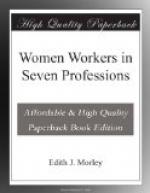In the Metropolitan area (exclusive of the City) half of the salary of all Sanitary Inspectors is paid out of the County Rate, and their duties are defined in Sections 107 and 108 of the Public Health (London) Act, 1891. As Medical Officers of Health and the public generally became more and more interested in the question of infant mortality, Women Inspectors were employed to investigate infant deaths, to visit houses where a birth had taken place and advise mothers on infant care, to manage milk depots, to weigh babies, and to assist at infant consultations, and to do a great deal of work which hitherto had not been considered the work of a Sanitary Inspector. There was never any question as to the value of the work done nor of the efficiency with which it was performed, but the Local Government Board Auditor took the view that it did not come within the scope of the order of 1891, defining the duties of a Sanitary Inspector, and he refused to sanction the payment out of the County Rate of half the salary of those women who were engaged in Health Visiting work. In March 1905, the borough of Kensington solved the difficulty for itself by appointing a Health Visitor and paying the whole of her salary out of the Local Rate; but less wealthy boroughs felt unable to do this. It was work which the Sanitary Authorities wanted to undertake; it was work which the London County Council and the Local Government Board were desirous of seeing performed, but this technical difficulty stood in the way. It was overcome by the inclusion in the London County Council General Powers’ Act of 1908, of Section 7, which empowered Sanitary Authorities in the Metropolitan area to appoint Health Visitors, and this enabled the London County Council to contribute half their salaries out of the County Rate. As a matter of fact, at the present time (November 1913) the whole of the salary of Health Visitors in London is being paid out of the Local Rate, as the Exchequer contribution account is completely depleted by the payment of the moiety of the salary of Sanitary Inspectors.
The essential difference between a Woman Sanitary Inspector and a Health Visitor is that the Woman Sanitary Inspector is a statutory officer with a legal position, having definite rights of entry and certain statutory powers for enforcing the Public Health Acts, while a Health Visitor is a purely advisory officer, with no legal status or right of entry or power to carry out any of the provisions of the Public Health Acts.
In actual practice, the title of Inspector has in no way proved an obstacle to successful health visiting, as may be demonstrated by an enquiry into the work now being carried on by Women Sanitary Inspectors in Sheffield, Leeds, Liverpool, Bradford, London, and other places. On the contrary, it has enabled officials to obtain an entry into dirty and insanitary places and to expose cases of neglect, which might otherwise have remained undiscovered.




